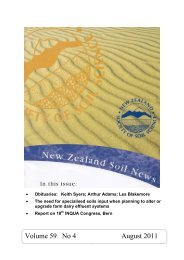Download - New Zealand Society of Soil Science
Download - New Zealand Society of Soil Science
Download - New Zealand Society of Soil Science
You also want an ePaper? Increase the reach of your titles
YUMPU automatically turns print PDFs into web optimized ePapers that Google loves.
to suggest a change to this anomaly and this was agreed to by the Faculty <strong>of</strong> <strong>Science</strong>. It remained as a<br />
12 point paper but lectures increased to 4 hours per week with one<br />
4-hour laboratory. It was still examined in two 3-hour examinations but with changed prescriptions<br />
reflecting its upgraded status.<br />
SOIL 201A Geology, mineralogy and geomorphology as related to soil formation. <strong>Soil</strong>-forming<br />
factors and processes. Chemical and physical properties <strong>of</strong> soils. <strong>Soil</strong> surveys and soil survey<br />
interpretation. <strong>Soil</strong> classification.<br />
SOIL 201B <strong>Soil</strong> conditions, physical, chemical and biological that influence plant growth. Nutrient<br />
cycling. Diagnosis <strong>of</strong> nutrient deficiencies and their correction by the use <strong>of</strong> fertilisers.<br />
Influence <strong>of</strong> forests and forest management on soil properties.<br />
4. 1993-2002 SOIL 202 <strong>Soil</strong> Properties and Processes<br />
SOIL 203 <strong>Soil</strong> Fertility<br />
During the 1980’s at the University <strong>of</strong> Canterbury, a change was occurring from large 12 point papers<br />
to smaller 6 point units in the BSc. This gave students greater flexibility in developing their degrees<br />
and was also associated with a gradual change to semesterisation <strong>of</strong> teaching. By about 1990, SOIL<br />
201 was one <strong>of</strong> about two remaining 12 point papers. Consequently, it was decided to seek a split into<br />
two 6 point papers to be taught respectively in the first and second halves <strong>of</strong> the year (the University<br />
was at this stage unwilling to use the word “semesters”).<br />
This proposal was accepted and the resulting papers were SOIL 202 and SOIL 203. Effectively, things<br />
remained pretty much as they had been for SOIL 201 (eg lecture and laboratory hours remained as<br />
they had been for SOIL 201) with SOIL 202 being taught and examined in the first half <strong>of</strong> the year and<br />
SOIL 203 being taught and examined in the second half.<br />
The opportunity was taken to upgrade the prescriptions <strong>of</strong> the two papers as follows:<br />
SOIL 202 <strong>Soil</strong> Properties and Processes <strong>Soil</strong> forming factors and processes. <strong>Soil</strong>-landform<br />
relationships and soil surveys. Mineralogical, physical and chemical properties <strong>of</strong> <strong>New</strong> <strong>Zealand</strong> soils.<br />
SOIL 203 <strong>Soil</strong> Fertility Chemical, physical and biological properties that influence plant growth.<br />
Nutrient deficiencies and fertiliser use.<br />
5. 2003 SOIL 202 discontinued<br />
Over several years, <strong>New</strong> <strong>Zealand</strong> forestry had undergone a marked change in emphasis from<br />
establishing and growing trees to their harvesting and utilisation. Discussion within the School <strong>of</strong><br />
Forestry led to a change in the BForSc degree structure with the consequent effect that, from 1999,<br />
only one <strong>of</strong> the two soils paper (SOIL 202) was compulsory though SOIL 203 was still included in<br />
the degree schedule but as an optional paper. Inevitably this led to a drop in student numbers in SOIL<br />
203 from 1999 onwards as some BForSc students understandably opted for other papers, in commerce<br />
particularly.<br />
By 2002 numbers in SOIL 203 had dropped to 12 which was too low to be viable. In addition the<br />
BForSc schedule was changed again, removing SOIL 203 as an optional alternative from 2003. All <strong>of</strong><br />
this meant that only one soils paper was going to be viable. Peter Almond who had been the main<br />
lecturer in SOIL 202 since 1991 wanted to be relieved <strong>of</strong> that teaching while John Adams who was the<br />
main lecturer in SOIL 203 was happy to continue with that paper. Consequently, SOIL 202 was<br />
discontinued as from 2003 and SOIL 203 became the only soil science paper <strong>of</strong>fered, replacing SOIL<br />
202 as the compulsory soils paper for the BForSc degree.<br />
57










